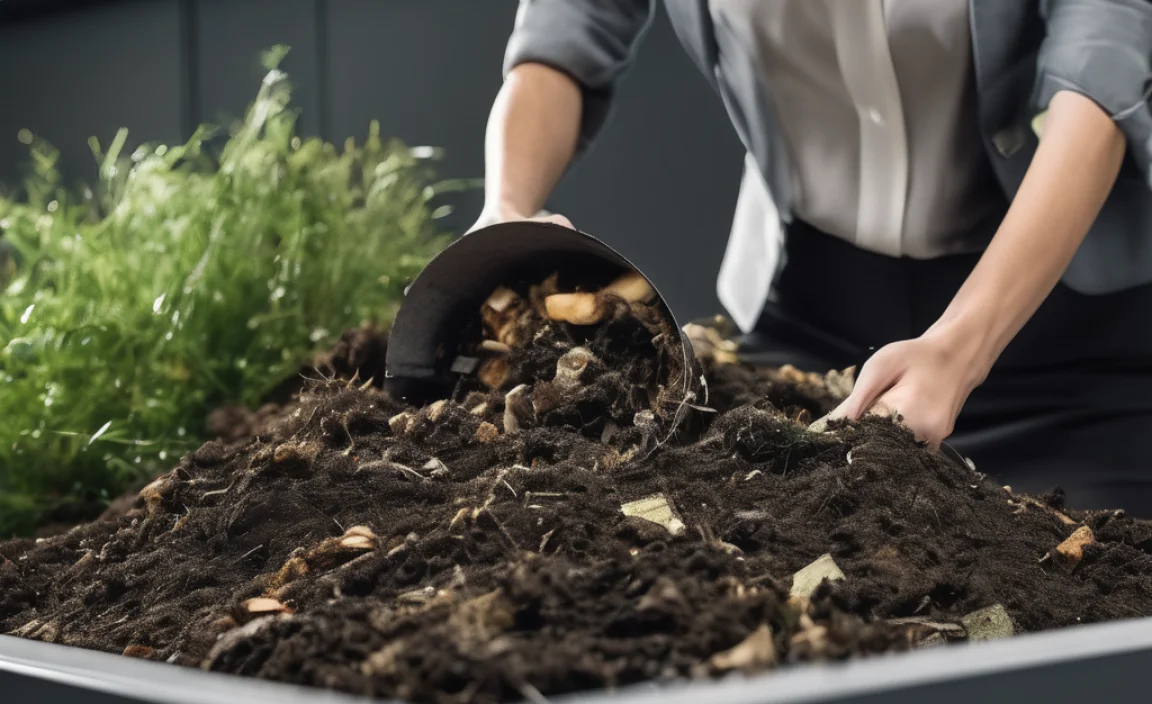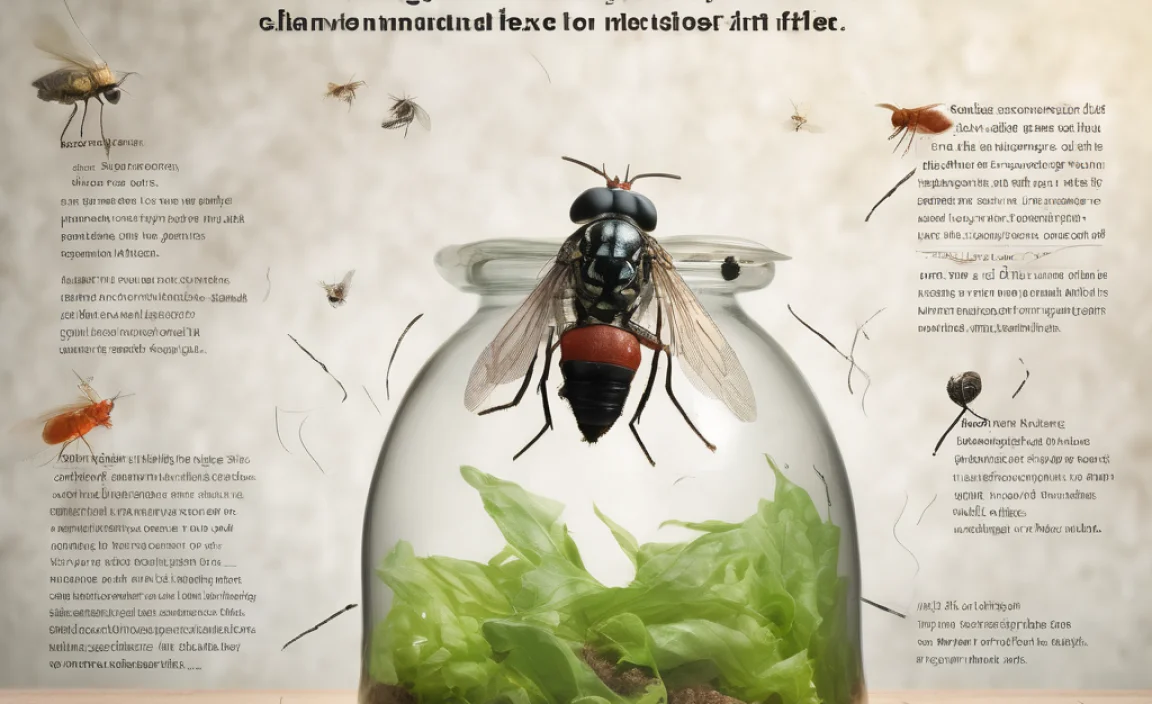Hey there! Ever feel a little guilty about the amount of food scraps and paper waste your office generates? You’re not alone. It’s a common problem, and figuring out what to do with it all can feel overwhelming. But what if I told you there’s a simple, eco-friendly way to tackle this? We’re talking about composting right in your office!
It might sound complicated, but it’s easier than you think. This guide will walk you through everything you need to know, step-by-step, so your office can go green and reduce its footprint without a huge fuss. Let’s dive in and make a positive change together!
Composting For Offices Ideas: Your Essential Guide to Going Green

Okay, imagine this: your office kitchen bin overflows with coffee grounds, fruit peels, and used tea bags. Now, picture that same waste being transformed into nutrient-rich soil for local gardens or even office plants. Pretty neat, right? Composting in the workplace isn’t just a trend; it’s a smart, sustainable practice that benefits everyone.
As Troy D Harn from TopChooser, I’m here to make complex things simple. Composting for offices can seem daunting, but with the right ideas and a little know-how, it’s totally achievable. We’ll cover the why, the how, and the best approaches to get your office composting smoothly. Think of me as your friendly neighbor showing you how to get this done without any headaches. Ready? Let’s get your office on the composting express!
Why Should Offices Compost? The Big Benefits
Before we get our hands dirty (figuratively, of course!), let’s chat about why composting is such a great idea for your office. It’s more than just a feel-good activity; it has real, tangible benefits.
Reduces Landfill Waste: This is the big one. Food scraps and compostable paper make up a significant portion of office waste. When these items go to landfill, they produce methane, a potent greenhouse gas. Composting diverts this waste, reducing your office’s environmental impact.
Creates Valuable Resources: Compost is often called “black gold” by gardeners. It’s a fantastic soil amendment that enriches soil, improves water retention, and reduces the need for chemical fertilizers. This compost can be used in local community gardens, parks, or even your office’s own green spaces.
Boosts Employee Morale and Engagement: Many employees want to work for companies that care about sustainability. Implementing a composting program shows your commitment to environmental responsibility, which can boost morale, foster a sense of community, and attract eco-conscious talent.
Cost Savings (Yes, Really!): While there might be initial setup costs, reducing the volume of waste hauled by waste management services can lead to lower disposal fees over time. Plus, if you use the compost internally, you save on purchasing soil and fertilizers.
Educational Opportunities: A composting program can be a fantastic way to educate staff about sustainability, waste reduction, and environmental stewardship. It’s a hands-on way to make a difference that everyone can participate in.
Getting Started: Essential Composting for Offices Ideas
So, you’re convinced it’s a good idea. Now, how do we actually do it in an office setting? The key is to find a system that fits your office’s size, culture, and resources. There are several approaches, from simple collection to more involved on-site systems.
1. The “We Collect, Someone Else Composts” Model
This is often the easiest entry point for offices. It involves collecting compostable materials on-site and then having a third-party service pick them up and compost them elsewhere.
How it works:
Set Up Collection Bins: Place clearly labeled bins for compostables in high-traffic areas like kitchens and break rooms. Make sure they are easy to use.
Educate Staff: This is CRUCIAL. Show everyone what can and cannot be composted. Clear signage and a brief orientation session go a long way.
Schedule Pickups: Partner with a local commercial composting service. They’ll provide specialized bins and a regular pickup schedule tailored to your office’s volume.
Pros:
Minimal disruption to office routines.
No need for on-site composting knowledge or management.
Reliable and efficient process.
Cons:
Ongoing service fees.
Less direct connection to the composting process for staff.
Who it’s best for: Larger offices, offices with limited space, or those prioritizing ease of implementation.
2. The “Office Bokashi” Method
Bokashi is a unique fermentation process that pre-composts food scraps. It’s anaerobic (meaning it doesn’t require oxygen) and uses a special bran inoculated with beneficial microbes.
How it works:
Get a Bokashi Bin: These are airtight containers with a spigot at the bottom.
Layer Scraps and Bokashi Bran: Add food scraps (including meat and dairy, which are tricky for traditional composting) to the bin, sprinkle with Bokashi bran after each layer.
Drain the “Bokashi Tea”: The spigot allows you to drain off a liquid nutrient that can be diluted and used as fertilizer or poured down drains to help clean them.
Ferment: Seal the bin and let it ferment for about two weeks.
Bury or Add to Compost Pile: After fermentation, the material is pickled. It needs to be buried in soil or added to a traditional compost pile to fully break down. This is where an office might need a partnership with a community garden or park for the final stage.
Pros:
Can handle meat, dairy, and oily foods.
Reduces odor because it’s an anaerobic process.
Produces a liquid fertilizer.
Compact and suitable for indoor use.
Cons:
Requires purchasing Bokashi bran regularly.
The fermented material still needs a second stage (burying/adding to compost) to fully decompose.
Can be a bit smelly if the seal isn’t perfect.
Who it’s best for: Smaller offices or departments looking for an indoor solution, especially if they have partners for the final decomposition stage.
3. The “Worm Composting (Vermicomposting)” System
Vermicomposting uses red wiggler worms to break down food scraps. It’s fascinating to watch and can be done indoors or outdoors.
How it works:
Get a Worm Bin: You can buy specific vermicomposting bins or build one. They need good ventilation and drainage.
Add Bedding: Shredded newspaper, cardboard, or coconut coir serves as the worms’ home.
Introduce the Worms: Red wigglers are special composting worms, not typical earthworms.
Feed Them Scraps: Feed your worms food scraps (avoiding meat, dairy, and oily foods). They’ll eat their way through the bedding and scraps.
Harvest “Worm Castings”: The worms produce nutrient-rich castings (their poop!), which are excellent fertilizer.
Collect “Worm Tea”: Liquids that collect can also be diluted and used as fertilizer.
Pros:
Produces high-quality fertilizer (worm castings).
Can be done indoors in a relatively small space.
Interactive and educational for staff.
Cons:
Requires careful management of moisture, temperature, and what you feed the worms.
Can be off-putting to some people.
The initial setup can seem a bit involved.
Who it’s best for: Offices with enthusiastic staff, a dedicated space, and a desire for a hands-on, educational program.
4. The “Community or Shared Garden Compost” Approach
If your office is part of a larger building complex or located near a community garden, you might be able to contribute to their existing composting efforts.
How it works:
Identify Opportunities: Talk to building management or local community garden organizers.
Partner Up: Establish a system for collecting specific compostable materials at your office and delivering them to the shared compost system.
Provide Clear Guidelines: Ensure your staff knows exactly what can go to the community compost.
Pros:
Leverages existing infrastructure.
Supports local green initiatives.
Relatively low setup effort for your office.
Cons:
Dependent on the existence and willingness of a community program.
May have limitations on what materials can be accepted.
Who it’s best for: Offices in shared buildings or with easy access to community gardening projects.
What Can Be Composted in an Office? (The “Yes” and “No” List)
This is where clarity is key for success. When people know what to throw where, confusion (and contamination) decreases.
Here’s a general guide, though it’s always good to check with your chosen composting service or system for specific guidelines.
| Can Be Composted (The “Greens” & “Browns”) | Should NOT Be Composted (Usually) |
|---|---|
| Food Scraps: | |
| Fruit and vegetable peels/scraps | Meat, poultry, fish, and bones (unless using Bokashi) |
| Coffee grounds and paper filters | Dairy products (milk, cheese, yogurt) (unless using Bokashi) |
| Tea bags (remove staples and any plastic tags) | Oily or greasy foods/scraps |
| Eggshells | Diseased plants |
| Paper Products: | |
| Paper towels (unsoiled) | Plastic wrappers, bags, or packaging |
| Napkins (unsoiled) | Styrofoam |
| Uncoated paper plates and cups (check for compostable certification) | Glossy or coated paper (like magazines, flyers with heavy ink) |
| Shredded paper (non-glossy junk mail, office paper) | “Compostable” certified plastics or serviceware that don’t break down in your specific system (check certifications!) |
| Other: | |
| Small amounts of sawdust (untreated wood) | Fats, oils, and grease |
| Dryer lint (from natural fibers like cotton) | Pet waste (dog or cat feces) |
| Plants and flowers (non-diseased) | Treated wood |
A Note on “Compostable” Packaging: Many modern offices use disposable cutlery, cups, and containers. Look for certifications like BPI (Biodegradable Products Institute) or CMA (Compost Manufacturing Alliance) on these items. Even then, ensure your composting partner or system can handle them. Not all facilities can!
Setting Up Your Office Composting Station: Practical Tips
The heart of a successful office composting program is a well-managed collection point. Here’s how to make yours work:
Choosing the Right Bins
Look for Clear Labeling: Bins should clearly state “Compost” or “Food Scraps” and include images of acceptable items. A “Landfill” bin nearby is also essential.
Size Matters: Choose bins that fit your space and anticipated volume. Smaller countertop bins can be used in kitchens, feeding into larger collection bins.
Easy to Clean: Opt for bins with removable liners or that are easy to wipe down. Hygiene is important!
Lids: Lids help contain odors and prevent pests. Consider bins with foot pedals for touch-free operation.
Location, Location, Location!
Kitchens and Break Rooms: These are natural hubs for food waste.
Near Printers/Copiers: For shredded paper.
Common Areas: Visible and accessible spots encourage participation.
Signage is Your Best Friend
Visual Aids: Use pictures of acceptable and unacceptable items. This is more effective than just words.
Keep it Simple: Avoid jargon. Make it immediately understandable for anyone passing by.
Interactive Elements: Consider a small chart or FAQ posted near the bins.
Who to Contact: Include contact information for the “Compost Champion” or whoever manages the program in case of questions.
The Role of the “Compost Champion”
Every successful office composting initiative benefits from a dedicated individual or small team – your ” Compost Champion(s).” This isn’t a full-time job but a role taken on enthusiastically.
Key Responsibilities:
Education & Training: Leading initial training sessions and providing ongoing reminders.
Monitoring Bins: Checking bins for contamination and helping to keep the composting station tidy.
Troubleshooting: Addressing any issues that arise, like odors or confusion about what’s compostable.
Communication: Keeping staff informed about program progress and successes.
Liaising: Acting as the point person for the composting service or external composting partners.
Having a point person makes the program feel supported and ensures accountability.
Measuring Success and Keeping it Going
How do you know if your composting program is working? Track a few key indicators.
Waste Audits: Periodically check your landfill bins. Is the volume decreasing? Are fewer compostable items ending up there?
Contamination Levels: Monitor how clean the compost bins are. High contamination means more education is needed.
Employee Feedback: Ask your colleagues what’s working and what could be improved.
Waste Hauling Bills: Compare your waste disposal costs before and after implementing composting.
To keep momentum:
Celebrate Milestones: Share successes, like the amount of waste diverted from landfill.
Regular Communication: Send out quick tips or reminders.
Integrate with Other Green Initiatives: Connect composting to broader company sustainability goals.
Make it Fun! Host a “Compost Challenge” or a small office party to mark achievements.
External Resources for Composting in Offices
To help you on your journey, here are some authoritative resources:
U.S. Environmental Protection Agency (EPA) – Composting at Home (While focused on home composting, the principles and ‘what to compost’ lists are highly relevant and informative for understanding the basics.)
University of Maryland Extension – Composting (Offers in-depth knowledge and best practices for various composting methods.)
EPA Commercial Food Waste Management (Information on how businesses can manage food waste, including composting options.)
These resources can provide deeper insights and data to support your office’s composting efforts.
Frequently Asked Questions About Office Composting
Q1: What’s the easiest way to start composting in an office?
The simplest approach is typically to partner with a commercial composting service. They provide bins and regular pickups, managing the composting process off-site. Your main tasks are setting up collection points and educating staff on what to compost.
Q2: Will an office compost bin smell bad?
If managed correctly, an office compost bin shouldn’t smell bad. Proper management includes using bins with lids, emptying them regularly, and educating staff on what goes in (avoiding meat/dairy in non-Bokashi systems). Commercial services handle larger volumes diligently to prevent odors.
Q3: How do we get employees to participate?
Success hinges on clear communication, easy-to-use systems, and visible leadership support. Explain the “why” and make it simple. Appoint a “Compost Champion” to answer questions and monitor progress. Fun reminders and celebrating small wins can also boost engagement.
Q4: What if our office doesn’t have any outdoor space or a place for a compost bin?
Many composting methods are suitable for indoor use. Bokashi bins and vermicomposting (worm bins) are compact and designed for indoor environments. If using a commercial service, you’ll only need space for the collection bins in your kitchen or break room.
Q5: Can we compost “compostable” serviceware like cups and cutlery?
This depends entirely on your composting system or service. Many commercial composting facilities can process certified compostable serviceware (look for BPI or CMA certifications). However, if you’re doing on-site composting (like worm bins or Bokashi), these items might not break down properly and should be avoided unless specifically cleared.
Q6: How much does it cost to set up office composting?
Costs vary. Commercial services have monthly fees based on bin size and pickup frequency. Bokashi bran and worm bins have upfront costs, plus ongoing supply purchases. The most budget-friendly option might be partnering with an existing community garden compost program if available.

I am passionate about home engineering. I specialize in designing, installing, and maintaining heating, ventilation, and air conditioning systems. My goal is to help people stay comfortable in their homes all year long.


